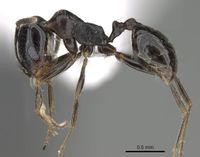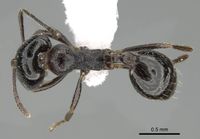Trichomyrmex almosayari
| Trichomyrmex almosayari | |
|---|---|

| |
| Scientific classification | |
| Kingdom: | Animalia |
| Phylum: | Arthropoda |
| Class: | Insecta |
| Order: | Hymenoptera |
| Family: | Formicidae |
| Subfamily: | Myrmicinae |
| Tribe: | Crematogastrini |
| Genus: | Trichomyrmex |
| Species: | T. almosayari |
| Binomial name | |
| Trichomyrmex almosayari Sharaf & Aldawood, 2016 | |
Sharaf et al. (2016) - This species was found foraging on dry sandy soil surrounding shrubs of Rhazya stricta Decnet (Apocynaceae) in Rawdhat Khorim, one of the most important natural protectorates in Saudi Arabia due to its diverse flora (Al-Farraj et al. 1997, Alfarhan 2001).
Identification
Sharaf et al. (2016) - Trichomyrmex almosayari can be immediately separated from all known African and Arabian species of the genus by the reniform eyes, the ventral eye margin feebly concave and the dorsal eye margin distinctly broadly convex.
Keys including this Species
Distribution
Latitudinal Distribution Pattern
Latitudinal Range: 26.36° to 25.38°.
| North Temperate |
North Subtropical |
Tropical | South Subtropical |
South Temperate |
- Source: AntMaps
Distribution based on Regional Taxon Lists
Afrotropical Region: Saudi Arabia (type locality).
Distribution based on AntMaps
Distribution based on AntWeb specimens
Check data from AntWeb
Countries Occupied
| Number of countries occupied by this species based on AntWiki Regional Taxon Lists. In general, fewer countries occupied indicates a narrower range, while more countries indicates a more widespread species. |

|
Estimated Abundance
| Relative abundance based on number of AntMaps records per species (this species within the purple bar). Fewer records (to the left) indicates a less abundant/encountered species while more records (to the right) indicates more abundant/encountered species. |

|
Biology
Castes
Nomenclature
The following information is derived from Barry Bolton's Online Catalogue of the Ants of the World.
- almosayari. Trichomyrmex almosayari Sharaf & Aldawood, in Sharaf, Salman, et al. 2016a: 12, fig. 6A-C (w.) SAUDI ARABIA.
- Type-material: holotype worker, 14 paratype workers.
- Type-locality: holotype Saudi Arabia: Riyadh Prov., Rawdhat Khorim, 25.38°N, 47.27°E, 574 m., 9.i.2015 (S. Salman); paratypes: 8 workers with same data, 5 workers with same data but 618 m., 2.vi.2013, 1 worker Riyadh Prov., Al Zulfi, Rawdhat Al Sabalah, 26.36°N, 44.98°E, 670 m., 25.x.2015 (Aldhafer, et al.).
- Type-depositories: KSMA (holotype), CASC, KSMA, WMLC (paratypes).
- Distribution: Saudi Arabia.
Unless otherwise noted the text for the remainder of this section is reported from the publication that includes the original description.
Description
Worker
Holotype. TL 2.60; HL 0.75; HW 0.67; SL 0.55; EL 0.20; ML 0.77; PW 0.40; PTL 0.22; PTW 0.12; PPL 0.15; PPW 0.17; CI 89; SI 82. Paratypes. TL 2.62–2.92; HL 0.70–0.75; HW 0.67–0.72; SL 0.52–0.60; EL 0.17–0.20; ML 0.75–0.80; PW 0.37–0.42; PTL 0.15–0.22; PTW 0.12; PPL 0.12–0.15; PPW 0.15–0.17; CI 93–96; EI 25–28; SI 74–90 (n = 5).
Head. Head short, only slightly longer than broad (CI 93–96), with feebly convex sides and emarginated posterior margin; anterior clypeal margin lacking teeth of any description; masticatory margin of mandibles armed with three teeth; eyes relatively large, with 12 ommatidia in the longest row (EL 0.25–0.27 × HW), reniform with ventral margin weakly but distinctly concave, dorsal margin distinctly broadly convex; scapes short, when laid back from their insertions failing to reach posterior margin of head (SI 74–90).
Mesosoma. Promesonotum strongly convex, descending evenly to a much lower, shallowly but distinctly impressed metanotal groove; propodeal spiracles circular.
Pilosity. Underside of head with crowded, long J-shaped ammochaete hairs forming a psammophore; two pairs of hairs on pronotum and mesonotum, propodeum bare, petiole and postpetiole each with one pair of long hairs, gaster with decumbent pubescence; cephalic pilosity shorter than body pilosity.
Sculpture. Mandibles longitudinally striolate; cephalic dorsum smooth and shining, except for scattered hair pits; area in front of eyes and behind posterior clypeal margin finely striolate; pronotal dorsum faintly shagreenate; mesosomal dorsum, sides, petiole and postpetiole finely and densely punctulate or shagreenate, general appearance dull; gaster smooth and polished.
Color. Dark brown to blackish brown; mandibles, antennae, and legs brownish.
Type Material
Holotype. SAUDI ARABIA: w, Riyadh Province, Rawdhat Khorim, 25.38˚ N, 47.27˚ E, alt. 574 m, 9 Jan. 2015, S. Salman leg. (King Saud Museum of Arthropods). Paratypes. SAUDI ARABIA: 4 w, same data as holotype (KSMA); 1 w, same data as holotype (California Academy of Sciences); 3 w, same data as holotype (KSMA, 1 without gaster); 5 workers, Riyadh Province, Rawdhat Khorim, 25.38˚ N, 47.27˚ E, alt. 618 m, 2 Jun. 2013, S. Salman leg. (KSMA); 1 w, Riyadh Province, Al Zulfi, Rawdhat Al Sabalah, 26.36˚ N, 44.98˚ E, alt. 670 m, 25 Oct. 2015, Aldhafer et al. leg. (World Museum, Liverpool).
Etymology
The patronym almosayari has been selected to honor the late Egyptian Islamic writer Dr. Mohammed Sayed Almosayar (1948-2008).
References
References based on Global Ant Biodiversity Informatics
- Sharaf M. R., S. Salman, H. M. Al Dhafer, S. A. Akbar, M. S. Abdel-Dayem, A. S. Aldawood. 2016. Taxonomy and distribution of the genus Trichomyrmex Mayr, 1865 (Hymenoptera: Formicidae) in the Arabian Peninsula, with the description of two new species. European Journal of Taxonomy 246: 1–36

